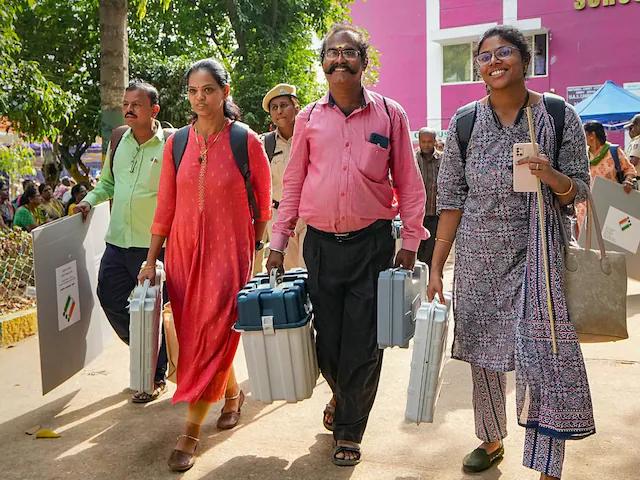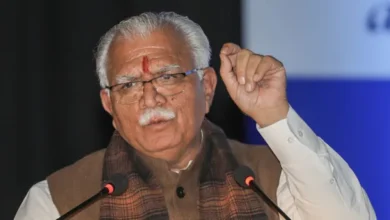Chatra Lok Sabha Polls 2024: BJP Leads In This Maoist-Hit Jharkhand Seat, Quelling Cousin Rivalry
Of the 14 parliamentary constituencies in Jharkhand, the Chatra Lok Sabha constituency is a broad one that includes the whole districts of Chatra and Latehar as well as a part of Palamu. At present, it consists of the following five segments of the legislative assembly: Panki, Simaria (SC), Manika (ST), Latehar (SC), and Chatra (SC). On May 20, the constituency will cast its fifth round of votes.

Former MP Dhiraj Prasad Sahu of the Congress was replaced by Sunil Kumar Singh of the BJP in 2014.
Candidates are Krishna Nand Tripathi (Congress) and Kalicharan Singh of the Bharatiya Janata Party (BJP).
DYNAMICS POLITICAL
The BJP seizes the initiative: the Chatra seat in Jharkhand is a mostly impoverished territory, with more than 95% of the population residing in rural regions. The BJP is well-positioned in this seat, having a significant advantage over its nearest opponent, the Congress. There is a direct rivalry between the two this time around as well, but if local reports are any indication, a BJP-biased poll is all but certain.
The Rashtriya Janata Dal (RJD) won the seat in Chatra (SC), the Congress won the seat in Manika (ST), and Jharkhand Mukti Morcha (JMM) won the seat in Latehar (SC), while the BJP won the seats in Simaria (SC) and Panki in the 2019 Assembly elections. There are a variety of political parties competing in the polls, all hoping to make a dent in the BJP’s massive lead, especially in the general elections.
The BJP saw an increase in its vote share to 57% in the 2019 Lok Sabha elections from 41.8% in the 2014 elections. With 16.2% of the vote, the Congress was its closest rival, followed by the RJD (9%), the BSP (2%), and others.
The choice to nominate Kalicharan Singh over incumbent Sunil Kumar Singh, who had been facing increasing anti-incumbency sentiment among voters, was accepted by the electorate but caused internal division among party members.
People are looking forward to the new BJP nominee, who is a local, and are perceived with hopes that he will deliver on promises that the previous MP fell short of. Two-time MP Sunil Kumar Singh is accused of not spending enough time with his constituents or successfully pushing for proper implementation of central schemes.
When a cousin rivalry gained prominence and threatened to divide BJP voters, the party experienced a brief setback. Son of the late MLA Mahendra Singh Bhogta, Jai Prakash Singh Bhogta was a former BJP legislator who submitted his candidacy to run independently after not receiving a ticket because he was seen as close to state president Babulal Marandi. Kalicharan Singh has severe concerns about this. Ramdeo, the cousin of the rebel leader, used his strength on the ground to lessen the damage and guarantee the BJP’s triumph. Due to this backlash and behind-the-scenes attempts to diffuse the issue, Bhogta withdrew his candidacy just in time for the withdrawal deadline and will now support the party.
In 2009, Bhogta, the national vice president of the BJP for SC Morcha, was elected from Simaria and went on to win Chatra on the Jharkhand Vikas Morcha (JVM) platform. The first chief minister of the state, Babulal Marandi, founded the JVM, a regional political organization, in 2006. In 2020, he merged it with the BJP. The BJP’s overall status is strengthened by this faction’s grasp on SC and ST votes in the area.
One of the main causes of the BJP’s high level of popularity among voters is the Modi factor. Though there have been flaws and a lack of collaboration between the Center and the state administration headed by Hemant Soren, the Prime Minister is recognized for a number of social programmes that have helped this rural area. Voters are hoping that, with assembly elections set for the end of 2024, they will finally benefit from significant programs like the PM Awas Yojana, which was introduced by the Soren administration but has remained unfinished ever since. Here, the Ram Mandir controversy has also gained some traction. Furthermore, the BJP benefits greatly from its hold on SC and ST votes, who account for about 50% of the electorate in Chatra. The BJP gains strength from the leaning of forward castes as well.
In the end, the area is hankering for a double-engine BJP administration, which has been aggressively promoted by the party by pointing to instances such as Yogi Adityanath’s Uttar Pradesh government. Most individuals believe that under these political circumstances, the advantages provided by the government to the people would be maximized.
Congress Putting Up a Decent Fight: Krishna Nand Tripathi is the Congress’s nominee from Chatra. 2009 saw Tripathi, a former Daltonganj MLA, win the election to the seat. The RJD, which has an MLA in Chatra, supports the party, which has an MLA in Manika. The party received 9% of the vote in the 2019 Lok Sabha elections, which might greatly help the Congress, which received 16.2% of the vote in the same election.
But Tripathi has a number of obstacles to overcome, including resistance from the RJD and inside the party, since some of the ally’s leaders are not happy with the party high command’s choice to back the Congress. Tripathi’s largest obstacle is also the significant Muslim vote base, which has always supported the Congress but is now disenchanted because its requests for a Muslim candidate have not been fulfilled. This group makes up around 13.5% of the total Muslim vote.
The Muslim community is dissatisfied that the grand alliance has not filed a single Muslim candidate for any of the 14 Jharkhand seats, despite the community’s strength in the polls and the Congress’s dependence on it. Chatra’s intellectual community has even pondered voting for the BJP, threatening to withhold their ballots in opposition to Tripathi. They allegedly demand that the Congress pick Muslim candidates from Godda, Giridh, Koderma, and Chatra and threaten to withhold their support from the party if it does not.
It remains to be seen whether the party can get all of the Muslim votes or if a split will occur, further harming the already dire circumstances facing the candidate. The ST voting bloc gives the party significant support in the Manika seat, which is designated for them.
In the run-up to the elections, the political assault by the Congress on the BJP at the state level has generated considerable political heat. Jairam Ramesh, the general secretary of the Congress, recently questioned the BJP, alleging that the Centre was treating the state like a stepmother and that Jharkhand was due billions of rupees in coal royalties and perks from the federal plan. Despite flaws on the other end, this approach has failed to establish the Congress as a popular alternative, despite its attempt to find any connection with voters.
KEY ISSUES Maoists: For residents and security personnel in Chatra, the Maoist problem continues to be problematic. There have been several reported losses from significant battles between the Maoists and the military in the area. In the most recent incident, the Central Reserve Police Force (CRPF) neutralized two cylinder bombs that were intended to target poll workers in order to interfere with the region’s preparations for the impending Lok Sabha elections. The event happened on April 14. In addition to the two and five kilogram explosives, wiring, bomb-making supplies, and everyday necessities were also taken. In a different event that happened in February of this year, two security officers lost their lives as Maoists and police engaged in gunfire. The fight between Sadar and Basisthnagar Jori in the Chatra Lok Sabha constituency happened in the Bairio forest.
Migration and Unemployment: In the Chatra area, unemployment has been a significant problem. Extreme Maoism is the reason for the lack of large industries. Companies steer clear of the area for fear of becoming a target for the Maoists. Thousands of young people leave their home state in pursuit of work as a consequence. However, the local populace often discriminates against these migrant laborers, forcing them to live in impoverished conditions without access to essential amenities like healthcare. As a result, many migrants from the Chatra area pass away. People have often bemoaned their suffering and called for additional employment in the area, but to no effect. They are dissatisfied with the state government’s disregard.
Railway connection: For many years, the area has been plagued by a pressing need for railway connection. Up until now, nothing has been done in spite of the people’s persistent requests and the local and state governments’ assurances. The MP is under fire from the community for allegedly breaking his pledge to build a railroad line in time for the next general election. The first Chatra-Gaya line was authorized by the Central government in 2022 as a solution to the problem. Since then, however, the project has stagnated and no work has been completed.
Owing to the extreme Maoist ideology and lack of employment opportunities, Chatra has gained notoriety as the state’s center for opium production. Major drug-busting operations have been conducted by the police across the area; the most recent operation took place in April 2024 and resulted in the recovery of 28 kg of opium valued at Rs 1.40 crore. The Maoist organizations in the area, which provide security to opium growers in return for a share of the earnings, also make money from the production, distribution, and sale of opium. Thus, growing opium production also indicates a rise in Maoist activity, which presents a challenge to the local government and security agencies.
Local Leader: The multitude of outside candidates who represent Chatra nationally is one of the primary concerns that has confused Chatra voters. People have often expressed their desire for a local, Chatra-born son of the land to represent them nationally. They think that since the MP is a foreigner who is ignorant of the problems facing the community, Chatra has not developed. But this time, the BJP has chosen a local man to challenge the sitting MP in the polls.
Civic Amenities: The district lacks many of the necessities of life, including street lighting, health, education, housing, piped water, power, and all-weather roads. One of the main reasons the sitting BJP MP was not nominated was the lack of implementation of central projects like the PM Awas Yojana and the Jal Jeevan Mission. People have bemoaned the lack of improvement in living circumstances since independence. Chatra was included to the list of the nation’s most underdeveloped areas in 2006 and has been there ever since.
Voter Demographics (2011 Census): 14,74,625 Voters Overall (2019)
4.7% in urban areas
95.3% of areas are rural.
Social Make-Up
SC: 28.2%
ST: 19.5%
Contents of Religion
Hindu: 83.5%
13.5% of Muslims
Christian: 2.94 percent
ENTREPRISE DEVELOPMENT
Super Thermal Power Plant: On March 4, the Prime Minister officially opened the largest Super Thermal power plant in the nation at Chatra. Being the first Supercritical Thermal Power Project in the nation, it uses up to one-third less water than traditional water-cooled condensers since it is designed with an air-cooled condenser (ACC). With a construction cost of Rs 7,526 crore, it can generate and provide up to 660 MW of power.
Passenger Ropeway: To access the Kauleshwari temple in the Chatra area, the state government has suggested building a ropeway system. Despite the fact that the bids were released in 2018, it are currently being built. There is a 2 km hiking trail and set of stairs from the foothill settlement of Hatwaria to the temple; however, it is difficult for elderly and disabled persons to ascend.
Varanasi-Ranchi-Kolkata Green Field Project: A 200-kilometer, six-lane highway would be built in Jharkhand, connecting the state’s Chatra district with Purulia-Bankura in West Bengal via the towns of Hazaribagh, Ramgarh, and Bokaro. The project would cost a total of Rs 12,000 crore.







